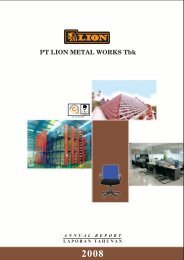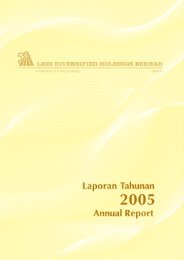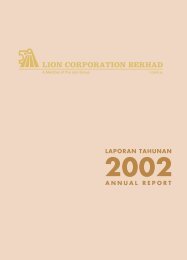directors - The Lion Group
directors - The Lion Group
directors - The Lion Group
Create successful ePaper yourself
Turn your PDF publications into a flip-book with our unique Google optimized e-Paper software.
Property Development Activities<br />
Property development revenue are recognised for all units sold using the percentage of completion method, by<br />
reference to the stage of completion of the property development projects at the balance sheet date as measured<br />
by the proportion that development costs incurred for work performed to-date bear to the estimated total property<br />
development costs on completion.<br />
When the outcome of a property development activity cannot be estimated reliably, property development revenue<br />
is recognised to the extent of property development costs incurred that is probable of recovery.<br />
Any anticipated loss on a property development project (including costs to be incurred over the defects liability<br />
period), is recognised as an expense immediately.<br />
Inventories of unsold completed development units are stated at the lower of cost and net realisable value.<br />
Accrued billings represent the excess of property development revenue recognised in the income statement over<br />
the billings to purchasers while advance billings represent the excess of billings to purchasers over property<br />
development revenue recognised in the income statement.<br />
Inventories<br />
Trading merchandise, finished goods, work-in-progress, raw materials and other products are valued at the lower<br />
of cost and net realisable value. Cost is determined principally on the ‘weighted average’ method. <strong>The</strong> cost of raw<br />
materials comprise the original purchase price plus cost incurred in bringing the inventories to their present<br />
locations and conditions. <strong>The</strong> cost of work-in-progress and finished goods comprise the cost of raw materials,<br />
direct labour, direct charges and an appropriate proportion of production overheads.<br />
Completed property units for sale are valued at the lower of cost and net realisable value. Cost is determined<br />
using the ‘specific identification’ method.<br />
Goods-in-transit are valued at the lower of cost and net realisable value.<br />
Net realisable value represents the estimated selling price in the ordinary course of business less selling and<br />
distribution costs and all other estimated costs to completion.<br />
In arriving at net realisable value, due allowance is made for damaged, obsolete or slow moving inventories.<br />
Construction Contracts<br />
When the outcome of a construction contract can be estimated reliably, contract revenue and contract costs are<br />
recognised by reference to the stage of completion of the contract activity at the balance sheet date, as measured<br />
by the proportion that contract costs incurred for work performed to date bear to the estimated total contract<br />
costs. Variations in contract work, claims and incentive payments are included to the extent that they have been<br />
agreed with the customers.<br />
When the outcome of a construction contract cannot be estimated reliably, contract revenue is recognised to the<br />
extent of contract costs incurred that are probable of recovery. Contract costs are recognised as expenses in the<br />
period in which they are incurred.<br />
When it is probable that total contract costs will exceed total contract revenue, the expected loss is recognised as<br />
an expense immediately as an allowance for foreseeable loss.<br />
Amount due from contract customers represents the excess of cost incurred todate and portion of profit or loss<br />
attributable to work performed todate over progress billings while amount due to contract customers represents<br />
the excess of progress billings over costs incurred todate and portion of profit or loss attributable to work performed<br />
todate.<br />
54

















